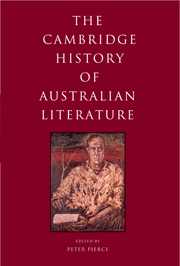Book contents
- Frontmatter
- Introduction
- FROM EUROPEAN IMAGININGS OF AUSTRALIA TO THE END OF THE COLONIAL PERIOD
- FROM THE LATE NINETEENTH CENTURY TO 1950
- 7 Australia’s Australia
- 8 The short story, 1890s to 1950
- 9 Australian drama, 1850–1950
- 10 ‘New words come tripping slowly’: Poetry, popular culture and modernity, 1890–1950
- 11 Australian fiction and the world republic of letters, 1890–1950
- 12 Australia’s England, 1880–1950
- TRAVERSES
- FROM 1950 TO NEARLY NOW
- Select bibliography
- Index
- References
7 - Australia’s Australia
from FROM THE LATE NINETEENTH CENTURY TO 1950
Published online by Cambridge University Press: 28 May 2011
- Frontmatter
- Introduction
- FROM EUROPEAN IMAGININGS OF AUSTRALIA TO THE END OF THE COLONIAL PERIOD
- FROM THE LATE NINETEENTH CENTURY TO 1950
- 7 Australia’s Australia
- 8 The short story, 1890s to 1950
- 9 Australian drama, 1850–1950
- 10 ‘New words come tripping slowly’: Poetry, popular culture and modernity, 1890–1950
- 11 Australian fiction and the world republic of letters, 1890–1950
- 12 Australia’s England, 1880–1950
- TRAVERSES
- FROM 1950 TO NEARLY NOW
- Select bibliography
- Index
- References
Summary
In two of the most plangent questions posed in an Australian poem, the young man who is the subject of Les Murray’s ‘The Trainee, 1914’ asks, ‘“Is war very big? As big as New South Wales?”’ Ardent, fearful, bewildered, he is readying himself to leave ante-bellum Australia and in particular its locus classicus, the world of rural innocence and purity. This ‘real Australia’, as many have called the outback, will be forever lost, irrevocably compromised by the experience of war. Perhaps the trainee will survive to return to the rural life that he had left, to become part of that recovery and redefinition of what was, and was not, Australia in the decades between the world wars. That effort is the subject of this chapter.
Its title, ‘Australia’s Australia’, invites comparison with Chapters 1 and 12, ‘Britain’s Australia’ and ‘Australia’s England’. The focus of this chapter is on assays made of Australia – by novelists, painters, poets, art historians, polemicists, lexicographers among others. This is no search for an Australian quintessence, although some of those considered here may have believed in it. The recoil from the Great War is explored as a significant impetus for a parochial, inward-looking gaze. That metropolitan culture, open to the outside world, whatever its discontents, remained of vital importance is undeniable, as is the fact that so many artists and writers – far from turning away from Europe – took themselves to live there.
In 1928, Norman Lindsay’s second son, Raymond, an artist and journalist, entered his historical canvas, ‘Major Johnston Announcing the Arrest of Governor Bligh, January 1808’, in the annual exhibition of the Society for the Arts. Writing in the Bulletin, Cecil Mann thought the quality of the work comparable to that of Norman at the same age. Dame Nellie Melba, the famous Australia diva, was also an admirer. She bought the painting, not for herself, but to present to the Geelong Art Gallery (she had given her last Australian concert in that city earlier in the year).
- Type
- Chapter
- Information
- The Cambridge History of Australian Literature , pp. 137 - 155Publisher: Cambridge University PressPrint publication year: 2009

